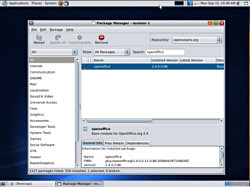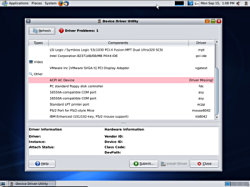Author: Gary Sims
Sun has been getting serious about opening up its software for a few years now. OpenSolaris, an open source Unix operating system like Linux and BSD, released in May, is its latest foray into the open source arena. I found OpenSolaris to be a production-ready OS that works equally well on desktops and servers.
OpenSolaris is released under Sun’s Common Development and Distribution License (CDDL), which isn’t compatible with the GNU Public License (GPL) used by Linux. This means that lots of the technology in OpenSolaris won’t be making its way into Linux any day soon. Also, OpenSolaris isn’t 100% free, as some components are available only in binary form under the OpenSolaris Binary License.
Installation
OpenSolaris comes as a live CD, which means it can be booted directly from CD without needing to be installed first. Once booted it can be installed to the hard disk. I downloaded it and burned the ISO image onto a CD, then booted up my test machine. You will need a modern AMD or Intel CPU and at least 512MB of memory to boot and run OpenSolaris.
Booting is painless. You need to answer only two questions — what keyboard you have and what desktop language you want — before the desktop appears. OpenSolaris uses the GNOME desktop environment, and this release comes with GNOME 2.20.2.
If you just want to play with OpenSolaris a bit, you can do that straight away and everything will run from the CD. I wanted to install OpenSolaris, so to do that I used the “Install OpenSolaris” tool on the desktop.
Installation is handled by a graphical installer. You need to select where OpenSolaris will be installed (noting that all data on the specified partition or disk will be erased), your time zone, the default language support, and locale-specific date formats. Finally, you need to set a root password, create one user account, and give the host a name. Sun have a lot of documentation to guide you through the installation process, including documents on installing OpenSolaris under VirtualBox and how to make a dual boot system.
Using it
The default installation of OpenSolaris contains several well-known applications, including Firefox (2.0.0.14), Thunderbird (2.0.0.12) and the GIMP (2.4.1), but surprisingly neither OpenOffice.org nor Sun’s Star Office is included.
To install an additional application you need to use the Package Manager, available from System -> Administration -> Package Manager). The OpenSolaris package repository contains more than 10,000 packages, including compilers, the Apache Web server, MySQL database, and PHP. It was while I was attempting to install OpenOffice.org that I came across my first hiccup.
By default OpenSolaris uses a service called Network Auto Magic, which configures the network interface automatically and tries to get an address via DHCP. On my home network it did that much, but for some reason it didn’t pick up my DNS servers. This meant that Package Manager couldn’t resolve the names of servers and so couldn’t connect to the Internet.
To resolve this I had to added name servers to /etc/resolv.conf and copy /etc/nsswitch.dns to /etc/nsswitch.conf. Once DNS was working I was able to install OpenOffice.org easily.
Unique features
OpenSolaris comes with some unique technologies, such as ZFS and DTrace, which can make it an attractive option for business.
The Zetabyte File System (ZFS) is a powerful file system designed for high storage capacities. It goes beyond filesystems like ext3 and NTFS by combining a filesystem, volume management, and RAID into one package.
DTrace is a system tracing tool that enables you to explore your system to understand how it works, track down performance problems across many layers of software, or locate the cause of aberrant behavior. You can learn more about it in the Solaris Dynamic Tracing Guide.
The question is why?
As I was using OpenSolaris, I asked myself, why would I want to use this rather than Linux? On the desktop, I don’t think their is much of a convincing answer. OpenSolaris uses GNOME, as does Linux (if you want it), so the user experience isn’t going to be much different. The available applications are similar, with all the popular open source applications available on both. OpenSolaris does try to support a large range of hardware and includes support for Nvidia graphics cards. It also provides a Device Driver Utility to try resolve driver problems.
In the server space, the argument is slightly different because of ZFS and DTrace. Without them, the verdict would be similar to that of the desktop, since all the major network services are available on both Linux and OpenSolaris, including newer technologies such as iSCSI and Xen. But ZFS isn’t really available for Linux (unless you want the FUSE implementation), and ZFS in other operating systems, such as FreeBSD, is still considered experimental. ZFS support makes OpenSolaris an interesting proposition.
Commercial support and the future
If you plan to use OpenSolaris in business, chances are you’ll want support from Sun. Currently the company offers commercial support for up to 18 months on any OpenSolaris release. By contrast, Canonical provide commercial support for Ubuntu Long Term Support versions for three years for desktops and five years for servers. Sun’s support interval may not be sufficient for some organizations, but it is a reasonable offering.
The next release of OpenSolaris, scheduled for November, promises such features as network installs, GNOME 2.24, KDE 4.1 as an alternative desktop environment, and infrastructure to turn any OpenSolaris host into a iSCSI target. The 2008.11 release should also offer improvements in the Web stacks available from the online repository. There are plans to provide the 10 most popular Web development frameworks (such as Rails and Django), provide the 10 most popular content management frameworks (including Zope, Plone, Joomla!, Drupal, and SilverStripe), and offer other similar frameworks for wiki and blogging.
Conclusion
By releasing OpenSolaris under a license that isn’t compatible with the GPL, Sun has made sure that certain key technologies will remain the purview of Solaris. If you are an open source purist, you might not like the way OpenSolaris is licensed and packaged, but if you are more pragmatic, OpenSolaris is a good choice, especially for use on a server.
Categories:
- Reviews
- Unix
- Open Source





